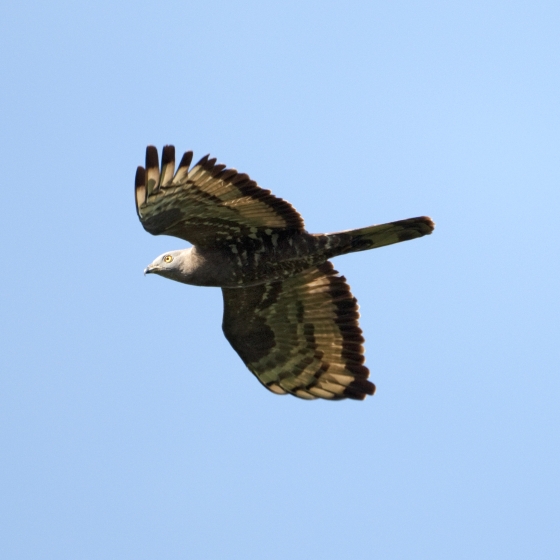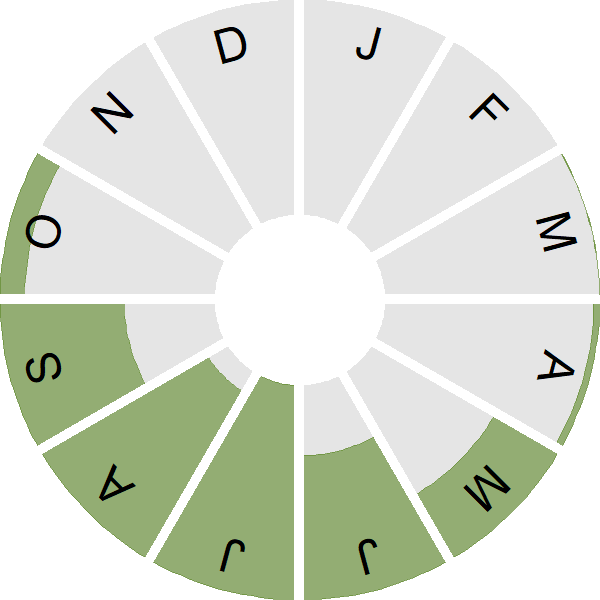Honey-buzzard

Introduction
One of the UK's rarest breeding birds, Honey-buzzard is a raptor with a predilection for the grubs of wasp and bees.
While undoubtedly a rare breeding bird, the Honey-buzzard's preference for secluded mature woodland and secretive behaviour – spending relatively little time in the air – means that it is probably under-recorded.
Honey-buzzard is a summer visitor, whose wintering grounds lie to the south of the Sahara.

Key Stats
Identification
ID Videos
This section features BTO training videos headlining this species, or featuring it as a potential confusion species.
Summer Buzzards: Buzzard and Honey Buzzard
Songs and Calls
Call:
Begging call:
Status and Trends
Conservation Status
Population Change
The Honey-buzzard is a rare breeding species in the UK but the population and trend are unclear. Rare Breeding Birds Panel data give a mean of 38 breeding pairs for the period 2015–2019 and suggest that there has been a slight increase in the 25 years to 2019 (Eaton et al. 2021). The breeding estimate is likely to be low as it is a difficult species to monitor. A population estimate of 100–150 pairs was suggested by Roberts & Law (2014) and a national survey has recently been undertaken which may give a more accurate population estimate once the data have been analysed. The Bird Atlas data suggest the number of occupied squares may have increased since 1988–91, but this is uncertain as this may be due to improved levels of detection and reporting rather than a genuine increase (Balmer et al. 2013).
Distribution
Honey-buzzard is a rare breeding species in the UK, with most records in southern England, plus Wales, north Yorkshire and Scotland.
Occupied 10-km squares in UK
or view it on Bird Atlas Mapstore.
European Distribution Map
Distribution Change
Change in occupied 10-km squares in the UK
or view it on Bird Atlas Mapstore.
Seasonality
Honey Buzzards are localised summer visitor, mostly arriving from May onwards, with a pulse of migrants in September in some years.
Weekly pattern of occurrence
The graph shows when the species is present in the UK, with taller bars indicating a higher likelihood of encountering the species in appropriate regions and habitats.

Movement
Britain & Ireland movement
Foreign locations of birds ringed or recovered in Britain & Ireland
Dots show the foreign destinations of birds ringed in Britain & Ireland, and the origins of birds ringed overseas that were subsequently recaptured, resighted or found dead in Britain & Ireland. Dot colours indicate the time of year that the species was present at the location.
- Winter (Nov-Feb)
- Spring (Mar-Apr)
- Summer (May-Jul)
- Autumn (Aug-Oct)

European movements
EuroBirdPortal uses birdwatcher's records, such as those logged in BirdTrack to map the flows of birds as they arrive and depart Europe. See maps for this species here.
The Eurasian-African Migration Atlas shows movements of individual birds ringed or recovered in Europe. See maps for this species here.
Biology
Productivity and Nesting
Nesting timing
Egg measurements
Clutch Size
Survival and Longevity
Survival is shown as the proportion of birds surviving from one year to the next and is derived from bird ringing data. It can also be used to estimate how long birds typically live.
View number ringed each year in the Online Ringing Report.
lifespan
Survival of adults
Survival of juveniles
Biometrics
Wing length and body weights are from live birds (source).
Ring Size
Classification, names and codes
Classification and Codes
- Order: Accipitriformes
- Family: Accipitridae
- Scientific name: Pernis apivorus
- Authority: Linnaeus, 1758
- BTO 2-letter code: HZ
- BTO 5-letter code: HONBU
- Euring code number: 2310
Alternate species names
- Catalan: aligot vesper europeu
- Czech: vcelojed lesní
- Danish: Hvepsevåge
- Dutch: Wespendief
- Estonian: herilaseviu
- Finnish: mehiläishaukka
- French: Bondrée apivore
- Gaelic: Clamhan-riabhach
- German: Wespenbussard
- Hungarian: darázsölyv
- Icelandic: Býþjór
- Irish: Clamhán Riabhach
- Italian: Falco pecchiaiolo
- Latvian: kikis
- Lithuanian: vakarinis vapsvaedis
- Norwegian: Vepsevåk
- Polish: trzmielojad (zwyczajny)
- Portuguese: bútio-vespeiro
- Slovak: vcelár lesný
- Slovenian: sršenar
- Spanish: Abejero europeo
- Swedish: bivråk
- Welsh: Boda Mêl
- English folkname(s): Bee Hawk
Research
Causes of Change and Solutions
Causes of change
As the trend is uncertain, it is also unclear what is driving the trend. Some studies suggest that they are highly successful breeders in the UK (Wiseman 2012) and hence productivity may be the demographic factor which is driving apparent increases.

